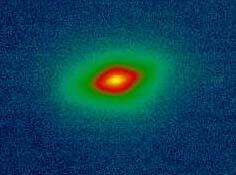
An infrared image of a massive, compact galaxy whose light has been traveling towards us for about 1.5 billion years. Astronomers have studied how these kinds of galaxies have evolved over the past 3.5 billion years, from a time when they were much smaller in size and mass until today, by using the Illustris computer simulation.
Massive quiescent galaxies have masses in stars of over one hundred billion Suns; our Milky Way by comparison has only about half that amount. In the local universe, the stars in these galaxies are mostly old and evolved, and the galaxies themselves are about fifty thousand light-years across and roughly elliptical in shape. The suspected younger counterparts to these objects are massive galaxies from the epoch of peak star formation activity, when the universe was about 3.5 billion years old. They were recently discovered in surveys of the universe and found to be as much as five times smaller in size than their descendants. How they grew so dramatically to become the massive galaxies we see in our cosmic neighborhood is poorly understood.
Two scenarios have been proposed to explain the growth of massive compact galaxies: the merger of galaxies, or their inflation by gas expelled in stellar winds or black hole jets. The problem has been to test these ideas and (since it is expected that at least these two processes are at work) to quantify the relative importance of each. There are just not enough massive compact galaxies known to be able to reach a convincing conclusion from statistical arguments, and so CfA astronomers Sarah Wellons, Vicente Rodriguez-Gomez, Annalisa Pillepich, and Lars Hernquist, together with their colleagues, undertook an analysis of Illustris: a cosmological computer simulation that tracks the evolution of the universe and its contents from a few million years after the big bang to today.
The scientists selected thirty-five massive compact galaxies in the simulation and watched what happened to them as they evolved over the past roughly 3.5 billion years. The galaxies started off with similar masses to within a factor of three, but by the current epoch their masses differed by a factor of twenty – different processes prompted some to grow much faster than others. (At the same time, the difference in their dark matter halo masses, originally a factor of five, grew to a factor of forty.) The team found that about half of the galaxies survived to become the cores of modern massive galaxies, about fifteen percent were destroyed in mergers with much larger galaxies, and about a third – the ones found in the least dense environments – evolved without much change. In particular, the team found that size growth of the galaxies was predominantly driven by the acquisition of new mass through mergers and accretion; winds played only a modest role. The new results are impressive demonstration of the power of Illustris to reveal details of cosmic evolution.
"The diverse evolutionary paths of simulated high-z massive, compact galaxies to z = 0," Sarah Wellons, Paul Torrey, Chung-Pei Ma, Vicente Rodriguez-Gomez, Annalisa Pillepich, Dylan Nelson, Shy Genel, Mark Vogelsberger and Lars Hernquist, MNRAS 456, 1030, 2016.
Related News
CfA Scientists Play Important Role in New NASA Mission
Runaway Stars Reveal Hidden Black Hole In Milky Way’s Nearest Neighbor
CfA Celebrates 25 Years with the Chandra X-ray Observatory
CfA Astronomers Help Find Most Distant Galaxy Using James Webb Space Telescope
Unexpectedly Massive Black Holes Dominate Small Galaxies in the Distant Universe
Distant Stars Spotted for the First Time in the Vast Magellanic Stream
CfA Scientists Help Reach New Milestone in Quest for Distant Galaxies
Astrophysicists Hunt for Second-Closest Supermassive Black Hole
The Tilt in our Stars: The Shape of the Milky Way's Halo of Stars is Realized
JWST Draws Back Curtain on Universe's Early Galaxies
Projects
2MASS Redshift Survey
AstroAI
Dark Energy Spectroscopic Instrument (DESI)
GMACS
For Scientists